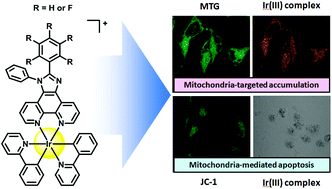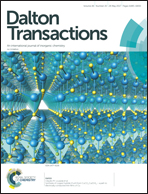Fluorinated cyclometalated iridium(iii) complexes as mitochondria-targeted theranostic anticancer agents†
Abstract
Six cyclometalated iridium(III) complexes bearing different numbers of fluorine atoms were synthesized. These complexes demonstrated much better anti-proliferation activities towards five tumour cell lines than the widely used clinical chemotherapeutic agent cisplatin. Moreover, the anti-proliferation activities were correlated to the number of substituted fluorine atoms. Colocalization and inductively coupled plasma-mass spectrometry (ICP-MS) indicated that this series of complexes could penetrate cell membranes rapidly and preferentially target mitochondria. Manifesting high selectivity between tumour cells and normal cells and remarkable sensitivity to a cisplatin-resistant cell line (A549R), complex Ir6 was successfully developed as a novel anticancer agent (with IC50 values of 0.5 ± 0.1 μM for HeLa, 1.1 ± 0.2 μM for HepG2, 1.5 ± 0.3 μM for BEL-7402, 0.8 ± 0.1 μM for A549, and 0.7 ± 0.2 μM for A549R cell lines). Further mechanism studies including mitochondrial membrane potential depolarization and caspase 3/7 activation revealed that Ir6 induced apoptosis via mitochondrial pathways. These results demonstrated that complex Ir6 might be a promising candidate as a mitochondria-targeted theranostic anticancer agent.



 Please wait while we load your content...
Please wait while we load your content...